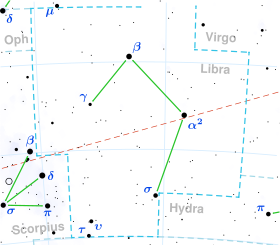Top Qs
Timeline
Chat
Perspective
HR 5455
Star in the constellation Libra From Wikipedia, the free encyclopedia
Remove ads
HR 5455 is a binary star[4] system located at a distance of 88 light years from the Sun[2] in the southern zodiac constellation of Libra. It has a yellow-white hue and is just barely visible to the naked eye with an apparent visual magnitude of 6.20.[1] The system is drifting closer to the Sun with a radial velocity of −66 km/s[1] and has a high proper motion, traversing the celestial sphere at the rate of 0.945″ per year.[9] It is a well-known high velocity star[10] system with a net heliocentric velocity of 158.8 km/s. The system is orbiting the through the galaxy with a high eccentricity of 0.62, which carries it from as close as 4.1 out to 17.5 kpc away from the Galactic Center.[1]
Remove ads
Binary system
Summarize
Perspective
This star was found to be a binary system based on variations in radial velocity data collected from the Hipparcos satellite.[11] The pair have an orbital period of 2.97 ± 0.21 years with photometric data yielding an angular separation of 21.28±2.88 mas.[4] Observations from the Gaia DR2 provide an estimated linear semimajor axis of 1.589 AU.[6] The eccentricity of the orbit is unknown, but has been assumed to be near zero.[4]
The visible member of this system, designated component Aa, has a stellar classification of F6V.[5] Superficially, it resembles 2–3[7] billion year old F-type main-sequence star that is generating energy through core hydrogen fusion. However, the star displays anomalies that are a challenge to explain through the normal star formation process. The first is the high velocity orbit of the star through the Milky Way, which would be very difficult for a young population I star to accomplish. The second is an abnormally low iron-to-magnesium [Fe/Mg] abundance ratio. This strongly suggests it is an ancient population II star that was formed during the early starburst phase of the galaxy about 12 billion years ago – a period when high levels of magnesium was released during supernovae explosions of massive stars. Both anomalies can be explained by a mass transfer that converted a much older star into a blue straggler.[4]
Evidence suggests that the companion, Ab, is a white dwarf star that evolved from an F- or G-type main-sequence star with a similar mass to the current primary. As component Ab became a red giant, it overflowed its Roche lobe and mass transfer took place. The white dwarf now has less than half the mass of the Sun, having transferred a substantial fraction of its mass to the current primary. The interaction would have circularized the orbit of the pair.[4]
Remove ads
Properties
The current primary has 1.32 times the mass of the Sun and 1.39 times the Sun's radius.[4] It has a low metallicity and is completely lacking in lithium.[4] The star is spinning with a projected rotational velocity of 16.2 km/s.[3] It is radiating 2.75 times the luminosity of the Sun[7] from its photosphere at an effective temperature of 6,341 K.[3] The system is a source for X-ray emission.[12]
Remove ads
References
Wikiwand - on
Seamless Wikipedia browsing. On steroids.
Remove ads

